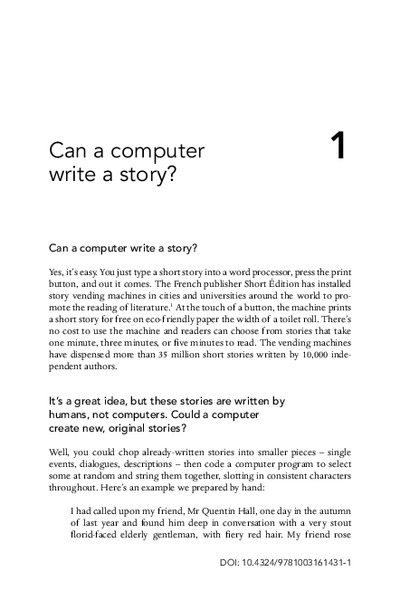Can a computer write a story?Zu finden in: Story Machines, 2022
 |
 |
 Diese Seite wurde seit 2 Jahren inhaltlich nicht mehr aktualisiert.
Unter Umständen ist sie nicht mehr aktuell.
Diese Seite wurde seit 2 Jahren inhaltlich nicht mehr aktualisiert.
Unter Umständen ist sie nicht mehr aktuell.
 Zusammenfassungen
Zusammenfassungen
 The introductory chapter asks whether computers can create new, original stories. Basic methods include chopping and reassembling previous stories, following flow charts of plot elements, and coding rules to generate story outlines, actions and dialogue. By the start of the 1990s, three books had been published that were claimed to have been written by computer programs. For the next two decades, a few researchers in computers and creativity coded programs that would work like human authors to plan, draft and revise well-formed stories. Then, in 2019, the OpenAI company announced a neural network program, GPT-2, that can continue the style of any writer without the need for expert programming. However, neural network text generators have fundamental weaknesses: they have no common-sense knowledge of the world, they cannot reflect on what they write, and they cannot explain their inner workings. The book explores a grand challenge to design successful story machines that write like human authors.
The introductory chapter asks whether computers can create new, original stories. Basic methods include chopping and reassembling previous stories, following flow charts of plot elements, and coding rules to generate story outlines, actions and dialogue. By the start of the 1990s, three books had been published that were claimed to have been written by computer programs. For the next two decades, a few researchers in computers and creativity coded programs that would work like human authors to plan, draft and revise well-formed stories. Then, in 2019, the OpenAI company announced a neural network program, GPT-2, that can continue the style of any writer without the need for expert programming. However, neural network text generators have fundamental weaknesses: they have no common-sense knowledge of the world, they cannot reflect on what they write, and they cannot explain their inner workings. The book explores a grand challenge to design successful story machines that write like human authors. Dieses Kapitel erwähnt ...
Dieses Kapitel erwähnt ...
 Dieses Kapitel erwähnt vermutlich nicht ...
Dieses Kapitel erwähnt vermutlich nicht ... 
 Nicht erwähnte Begriffe | Chat-GPT, Generative Pretrained Transformer 4 (GPT-4), GMLS & Bildung |
 Tagcloud
Tagcloud
 Anderswo finden
Anderswo finden
 Volltext dieses Dokuments
Volltext dieses Dokuments
 Anderswo suchen
Anderswo suchen 
 Beat und dieses Kapitel
Beat und dieses Kapitel
Beat hat Dieses Kapitel während seiner Zeit am Institut für Medien und Schule (IMS) ins Biblionetz aufgenommen. Beat besitzt kein physisches, aber ein digitales Exemplar. (das er aber aus Urheberrechtsgründen nicht einfach weitergeben darf). Es gibt bisher nur wenige Objekte im Biblionetz, die dieses Werk zitieren.









 Computer
Computer Generative Machine-Learning-Systeme (GMLS)
Generative Machine-Learning-Systeme (GMLS) Generative Pretrained Transformer 3 (GPT-3)
Generative Pretrained Transformer 3 (GPT-3) GPT-2
GPT-2 Kreativität
Kreativität Microsoft
Microsoft Programmieren
Programmieren
 , 628 kByte)
, 628 kByte)  Biblionetz-History
Biblionetz-History